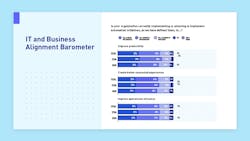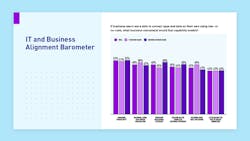Seventy percent of automation initiatives are being hindered by security concerns and data silos, according to a report from Mulesoft. As organizations increasingly look to automation to improve efficiency and productivity, MuleSoft’s IT and Business Alignment Barometer report, in partnership with Coleman Parkes Research, also revealed opportunities for companies to enable faster innovation across their organizations. MuleSoft surveyed 2,400 global IT and business decision makers.
IT and business teams working closely together can shrink or even eliminate organization silos, significantly reducing time to market. The report shows that almost nine out of 10 (87%) say IT and business alignment has improved over the past 12 months leading to a number of benefits, including improved collaboration, operational efficiency and better customer experience (Figure 1).
“IT and business alignment is no longer a nice-to-have. It’s essential to meeting the urgency of today’s digital imperatives,” says Brent Hayward, CEO, MuleSoft. “Delivering innovation fast requires reusable, secure assets the business can self-serve to quickly launch new digital experiences, products and services. As IT and business teams drive automation initiatives forward, empowering more people—developers and nondevelopers alike—to connect data and apps in a secure, yet frictionless way will be key to organizations' future success.”
Based on a global study of 2,400 IT decision makers (ITDMs) and business decision makers (BDMs), the MuleSoft IT and Business Alignment Barometer also highlights organizations’ business priorities and challenges over the next 12 months.
In an all-digital, work-from-anywhere world, it’s important to sense and respond to changing market dynamics and the needs of customers and employees with speed, agility and efficiency, according to the MuleSoft report. Automation has become a rising focus for many organizations to drive convenience, speed and cost reductions.
The report recognizes three notable findings:
- Operational efficiency is top of mind for businesses: Improving operational efficiency (54%), creating better connected customer experiences (50%), improving productivity (49%), becoming more agile for change (48%) and becoming more data-driven (45%) are organizations’ top five business priorities.
- There’s automation everywhere: 95% of organizations have implemented or are in the process of implementing automation initiatives, such as streamlined employee onboarding processes, to improve productivity. Ninety-three percent see automation as a means to create better-connected customer experiences and to improve operational efficiency.
- IT leads automation initiatives: Just over two-thirds (67%) of organizations say their automation initiatives are IT-led, that is, driven by the IT department and the technology that is available (Figure 2).
Figure 2: Just over two-thirds of organizations say their automation initiatives are IT-led, that is, driven by the IT department and the technology that is available. Source: Mulesoft
Security and governance, along with data distributed across multiple apps and platforms, continue to pose a challenge to automation initiatives and hinder innovation, the report indicates.
Security concerns are slowing down the pace of innovation. The majority (87%) of IT and business leaders say that security and governance concerns are slowing down the pace of innovation.
Disparate systems are causing security headaches. Almost three-quarters (73%) of organizations say the integration of disparate systems has increased their concerns around data security and governance. Thirty-one percent say it had significantly increased concerns.
Organizations are still wary of empowering nontechnical users. Most organizations recognize the need to empower business teams to help to take the operational strain off IT. However, the majority remain wary about the security implications; and 87% admitted security concerns were holding them back at least to some degree from empowering nontechnical users to integrate data sources (Figure 3).
Figure 3: The majority of respondents remain wary about the security implications; and 87% admitted security concerns were holding them back at least to some degree from empowering nontechnical users to integrate data sources. Source: Mulesoft
To overcome integration challenges and become more agile, IT and business teams need to work together to co-create value and keep pace with the speed of digitalization. IT teams can focus on producing secure and governed reusable assets and empower business teams to integrate and self-serve these IT-approved assets to deliver innovation faster.
COVID-19 has sparked a new focus on business agility. More than three-quarters (78%) of organizations say improving business agility to remain competitive will be extremely important in the future. This is a notable increase from 68% who said it was a focus pre-pandemic.
IT increasingly drives business outcomes. The majority (88%) of business and IT leaders agree that IT has become even more important in driving business outcomes in the past 12 months. Nearly half (48%) say it has become significantly more important.
Figure 4: Low-code or no-code would enable organizations to improve productivity, become more data-driven, improve operational efficiency, create better connected customer experiences and become more agile for change. Source: Mulesoft
The value of integration is recognized by the business. Almost nine in 10 (87%) BDMs feel that improved integration will help them meet their business objectives; and 39% say it would help them a lot.
Empowering business users to create connected experiences will drive agility. The vast majority (86%) of organizations agree business outcomes would improve if business users were able to use low or no code to securely connect apps and data on their own to create connected experiences. This capability would enable organizations to improve productivity (52%), become more data-driven (48%), improve operational efficiency (48%), create better connected customer experiences (46%) and become more agile for change (45%) (Figure 4).
Mike Bacidore is the editor in chief for Control Design magazine. He is an award-winning columnist, earning a Gold Regional Award and a Silver National Award from the American Society of Business Publication Editors. Email him at [email protected].
About the Author
Mike Bacidore
Editor in Chief
Mike Bacidore is chief editor of Control Design and has been an integral part of the Endeavor Business Media editorial team since 2007. Previously, he was editorial director at Hughes Communications and a portfolio manager of the human resources and labor law areas at Wolters Kluwer. Bacidore holds a BA from the University of Illinois and an MBA from Lake Forest Graduate School of Management. He is an award-winning columnist, earning multiple regional and national awards from the American Society of Business Publication Editors. He may be reached at [email protected]

Leaders relevant to this article:





